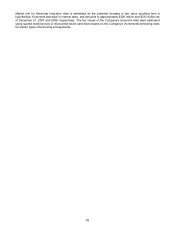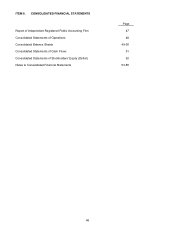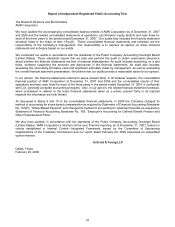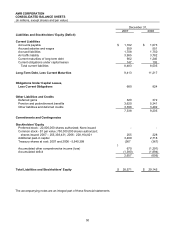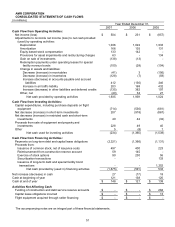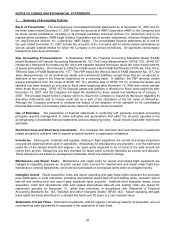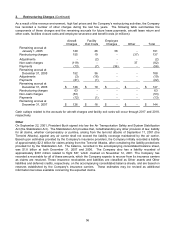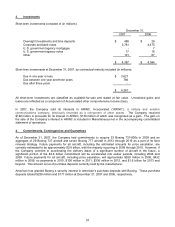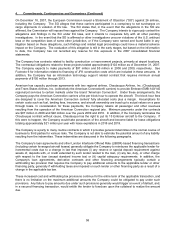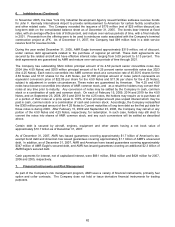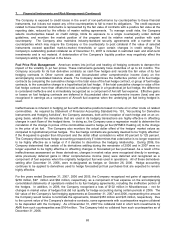American Airlines 2007 Annual Report Download - page 56
Download and view the complete annual report
Please find page 56 of the 2007 American Airlines annual report below. You can navigate through the pages in the report by either clicking on the pages listed below, or by using the keyword search tool below to find specific information within the annual report.
53
NOTES TO CONSOLIDATED FINANCIAL STATEMENTS
1. Summary of Accounting Policies
Basis of Presentation The accompanying consolidated financial statements as of December 31, 2007 and for
the three years ended December 31, 2007 include the accounts of AMR Corporation (AMR or the Company) and
its wholly owned subsidiaries, including (i) its principal subsidiary American Airlines, Inc. (American) and (ii) its
regional airline subsidiary, AMR Eagle Holding Corporation and its primary subsidiaries, American Eagle Airlines,
Inc. and Executive Airlines, Inc. (collectively, AMR Eagle). The consolidated financial statements as of and for
the year ended December 31, 2007 include the accounts of the Company and its wholly owned subsidiaries as
well as variable interest entities for which the Company is the primary beneficiary. All significant intercompany
transactions have been eliminated.
New Accounting Pronouncement In September 2006, the Financial Accounting Standards Board (FASB)
issued Statement of Financial Accounting Standards No. 157 “Fair Value Measurements” (SFAS 157). SFAS 157
introduces a framework for measuring fair value and expands required disclosure about fair value measurements
of assets and liabilities. On February 6, 2008 the FASB issued a final FASB Staff Position (FSP) No. FAS 157-b,
“Effective Date of FASB Statement No. 157”. This FSP delays the effective date of FASB Statement No. 157, Fair
Value Measurements, for all nonfinancial assets and nonfinancial liabilities, except those that are recognized or
disclosed at fair value in the financial statements on a recurring basis. In addition, the FSP removes certain
leasing transactions from the scope of SFAS 157. The effective date of SFAS 157 for nonfinancial assets and
liabilities has been delayed by one year to fiscal years beginning after November 15, 2008 and interim periods
within those fiscal years. SFAS 157 for financial assets and liabilities is effective for fiscal years beginning after
November 15, 2007, and the Company will adopt the standard for those assets and liabilities as of January 1,
2008. The principal impact to the Company will be to require the Company to expand its disclosure regarding its
derivative instruments and to include credit risk as a part of the calculation of the fair value of derivatives.
Although the Company continues to evaluate the impact of the adoption of this standard on its consolidated
financial statements, the Company believes the impact of adoption will be immaterial.
Use of Estimates The preparation of financial statements in conformity with generally accepted accounting
principles requires management to make estimates and assumptions that affect the amounts reported in the
accompanying consolidated financial statements and accompanying notes. Actual results could differ from those
estimates.
Restricted Cash and Short-term Investments The Company has restricted cash and short-term investments
related primarily to collateral held to support projected workers’ compensation obligations.
Inventories Spare parts, materials and supplies relating to flight equipment are carried at average acquisition
cost and are expensed when used in operations. Allowances for obsolescence are provided - over the estimated
useful life of the related aircraft and engines - for spare parts expected to be on hand at the date aircraft are
retired from service. Allowances are also provided for spare parts currently identified as excess and obsolete.
These allowances are based on management estimates, which are subject to change.
Maintenance and Repair Costs Maintenance and repair costs for owned and leased flight equipment are
charged to operating expense as incurred, except costs incurred for maintenance and repair under flight hour
maintenance contract agreements, which are accrued based on contractual terms when an obligation exists.
Intangible Assets Route acquisition costs and airport operating and gate lease rights represent the purchase
price attributable to route authorities (including international airport take-off and landing slots), domestic airport
take-off and landing slots and airport gate leasehold rights acquired. Indefinite-lived intangible assets (route
acquisition costs and international slots and related international take-off and landing slots) are tested for
impairment annually on December 31, rather than amortized, in accordance with Statement of Financial
Accounting Standards No. 142, “Goodwill and Other Intangible Assets” (SFAS 142). Airport operating and gate
lease rights are being amortized on a straight-line basis over 25 years to a zero residual value.
Statements of Cash Flows Short-term investments, without regard to remaining maturity at acquisition, are not
considered as cash equivalents for purposes of the statements of cash flows.




